Wildfires burn across the region as drought continues
 Smoke rises from the Collett Ridge Fire near Andrews. USFS photo
Smoke rises from the Collett Ridge Fire near Andrews. USFS photo
For the first time since 2016, Western North Carolina is in the midst of a severe drought coupled with an active fall wildfire season . Research shows that’s right on schedule.
“We have fire history studies in this area that show that typically our forests in the Southern Blue Ridge on average burned every five to seven years … We’re right about on that timeline,” said Jenifer Bunty, public affairs specialist for the U.S. Forest Service’s National Forests in North Carolina.
As of press time Nov. 14, nearly 6,000 acres of active wildfires were burning across Western North Carolina, with more just outside state lines. Most of that acreage is contained in the 5,335-acre Collett Ridge Fire near Andrews, which became the first significant wildfire of the season after lightning ignited a remote area of the Nantahala National Forest Oct. 23. The fire burned with 0% containment for weeks, with wet weather last weekend helping firefighters make significant progress — the blaze is now 71% contained. Firefighters are also combating the 434-acre Poplar Drive Fire in Henderson County, now 75% contained, and the 36-acre Alum Knob Fire in Madison County, currently 40% contained.
Three more fires are burning in the Cherokee National Forest in Tennessee — the 536-acre Tweed Fire straddling Greene and Cocke counties is 60% contained, the 540-acre Buck Bald Fire in Polk County 3 miles north of Farner is 60% contained and the 103-acre Bullet Fire in Monroe County is 20% contained. In South Carolina, the 675-acre Mill Mountain Fire burning west of Lake Jocassee is 50% contained.
Hundreds of additional acres are still burning but designated as controlled. The 310-acre East Fork Fire in Jackson County is now 80% contained, and the 36.5-acre Cascade Lake Road Fire in DuPont State Recreational Forest is 100% contained.

Related Items
A firefighter battles the Poplar Drive Fire in Henderson County. NCFS photo
While no structures have yet been damaged in the other fires, the Poplar Drive Fire has so far destroyed one home, two cabins and three outbuildings, also damaging a second home. Several trails and roads are closed, including the Foothills Trail and Burrells Ford Campground near the Mill Mountain Fire; Rim Trail from Big Stamp to Shinbone and the area past the intersection of Little Fires Creek Road and Fires Creek Road near the Collett Ridge Fire.
The Southern Appalachians are a fire-adapted landscape , meaning that fire is a beneficial and natural part of the region’s ecology. But land managers try to accomplish that through controlled burns, not wildfires, which can be expensive, disruptive and destructive. On Nov. 8, Gov. Roy Cooper declared a state of emergency due to the wildfires in WNC and statewide drought.
Sudden onset
The fires arrived in the wake of a drought that is as sudden as it is severe. At the end of August, Western North Carolina was overall wetter than usual, with heavy rain during the last few days of the month dropping well over an inch in most places. But in September, the spigot turned off, with weather remaining dry through October and thus far into November. In September and October combined, Highlands received only 3.47 inches of rain, a fraction of the normal 14.45 inches. Franklin’s 1.88 inches was less than a quarter the normal 8.09. Waynesville was a bit wetter at 3.81 inches but still well below the normal 7.25 inches.
“We were going a week or two at a time without seeing any rainfall at all,” said Corey Davis, assistant state climatologist for the N.C. State Climate Office.
This prolonged lack of rain plunged the region into a sudden and severe drought. In just six weeks, Western North Carolina has gone from sufficiently moist minus a few patches of abnormal dryness in the Sept. 26 drought map to almost completely covered by severe drought in the most recent map , published Nov. 7. Of North Carolina’s 100 counties, 31 are in severe drought, 39 are in moderate drought and 26 are abnormally dry. Burn bans cover the entire western region.


The drought situation in 2016 (above, published Nov. 15, 2016) was much worse than the one described in the most recent map based on data through Nov. 7. U.S. Drought Monitor of N.C. maps
That’s a serious drought situation, but not nearly as bad as the one backdropping the catastrophic wildfire season of 2016. Ultimately 48,000 acres of wildfire emanated from the national forests west of Asheville, followed by the Chimney Tops Fire in the Great Smoky Mountains National Park that burned nearly 18,000 acres and killed 14 people as it ravaged Gatlinburg. The drought that fueled it all took hold in the spring; by the time fire season kicked off in late October, four counties were already one step beyond severe drought in the extreme drought designation. When rain finally arrived Nov. 29, six counties were in exceptional drought and nine in extreme drought, with 42 additional counties under lesser designations.
“When you think about a drought that only started building a couple months ago, you wouldn’t expect that sort of impact to be present at this point so early on,” Davis said of the current fire season.
But other factors have conspired to form “in some ways a worst-case scenario,” he said. A hard freeze in early October followed by heavy leaf fall later in the month created an abundance of easily flammable fuel. This coupled with abnormally low humidity and warm temperatures to make conditions even more favorable for fire.

Firefighters work overnight to control the Collett Ridge Fire near Andrews. Bobby Ellis photo
“We’re used to seeing relative humidity levels this time of the year, 40, 50%,” Davis said. “But we were down below 20% for several afternoons. That also helps things to dry out very quickly, and that’s when some of these larger fires had really started and really spread a lot.”
Record warm temperatures only exacerbated the problem. Asheville, which has data going back 129 years, logged a high of 82 degrees Nov. 9 — setting a new record.
Waiting for relief
Fire managers and weather watchers had hoped that wet weather predicted last weekend might help put a dent in things. But precipitation proved minimal, with most places receiving only a quarter inch or so of rain. That’s more than some places have had in weeks, but in a normal fall, about three times that amount would be falling every week.
The rain helped firefighters get a handle on the blazes already burning, but it’s far from enough to put them out — or to prevent new fires from popping up, said Greg Philipp, assistant fire management officer for the U.S. Forest Service’s National Forests in North Carolina.
“It’s going to take many rain events, two to three days apart,” he said. “It doesn’t need to be a lot of rain. It just needs to be several days after each other. So that quarter inch three times a week would make a difference.”
Despite the drought, warm temperatures and low humidity, firefighters aren’t seeing the extreme fire behavior they battled in 2016, when wildfires easily jumped handlines and needed large barriers like roads and rivers to contain them. That’s partially because it’s not yet as dry as it was in 2016. The largest fuels in the forest are still 9%-10% moister this year than they were in 2016, Philipp said.
For now, the weather is back to being warm and dry. Though the forecast does hold some chance for rain, Philipps isn’t counting on it.
“September was incredibly dry. Predictions were relief in October. October was incredibly dry. predictions were relief in November. The relief was that quarter inch rain we got one time a couple days ago. Now they’re saying relief in December,” he said. “We’re still ordering resources. We are still staffing up, we are still prepared, and we’ll let the rain close us out. We’re not going to close that based on predictions.”
Predictions do call for wetter weather with the El Niño pattern expected to arrive this winter — but it’s hard to say when that will happen, and how much moisture it will bring. Some years, El Niño has arrived in the early fall, while in others, it’s been as late as January, Davis said.
“We do still have confidence that at some point we’ll get into a little bit wetter pattern,” Davis said. “I think it’s also interesting just to remember if we look back the last two or three years, those were La Niña years, which tend to be drier, and they were drier in many areas. But we still had a net improvement in drought conditions in each of those cases.”
Regardless of when La Niña arrives, Davis said, it will likely take a while to get out of a drought. Most places in the mountains are 4-6 inches below normal, and with hurricane season past there’s little chance to get that much rain from a single event. The most realistic remedy would be chewing away at it over the winter through one or two events per week that bring an inch or two apiece.
“That’s not going to mean we get rid of the drought all in one month,” he said. “It may not even mean we get rid of this drought all in one season. But at least I think that would tamp down some of the impacts that we’re seeing now.”
Preparing through partnerships
While forecasters like Davis continue to keep their eyes on the sky, firefighters are staying tuned to the task at hand. Between the Collett Ridge, Poplar Drive and Alum Knob wildfires, about 400 people are on scene representing a multitude of federal, state and local agencies.
“These lines on the map that say it’s a national forest or a state park or even a state boundary — ecological problems like fire don’t respect those boundaries, so we try to take this all hands, all lands approach to solving these problems and keeping our forests healthy and communities safe,” Bunty said.
That approach is somewhat new and grew its roots in 2000, during the aftermath of a severe wildfire season in the western part of the country.
“You had this watershed moment,” said Tom Dooley, director of forest conservation for The Nature Conservancy in South Carolina. “Folks within The Nature Conservancy sat down with counterparts in the Department of the Interior and the U.S. Forest Service and said, ‘What needs to happen to try and address and resolve some of these larger fire problems?’”
This led to creation of the Fire Learning Network , a national organization The Nature Conservancy staff coordinate to foster collaboration and coordination between the more than 750 partners it engages.
“The core values of how do we put people together in a collaborative setting to talk about and plan for putting fire on the ground as well as putting out the bad fires is really what it’s all about,” Dooley said.
He acknowledges that summary can sound “really nebulous” but says these efforts have yielded tangible results. Fire Learning Network efforts began in earnest in the Southern Blue Ridge region in 2007, offering opportunities for professionals from across the region to gather for training and planning efforts — and to build critical relationships with their counterparts in previously siloed agencies.
“You can hear people that were out on the lines in 2016 saying, ‘Because of us getting together regularly, we weren’t meeting cold on the fire line,’” Dooley said.

Rugged terrain has made containment Rugged terrain has made containment a struggle on the Collett Ridge Fire. Bobby Ellis photo
A major wildfire requires an all-hands-on-deck approach. Firefighters might come from multiple federal and state agencies, as well as departments staffed by employees of various local governments or by volunteers. Simple things like knowing the names, faces and cell phone numbers of leaders from other organizations or being aware of what firefighting resources another agency possesses can be critical to mounting an effective response.
“Once those fires started to be suppressed, put out, those partnerships really just catalyzed even more,” Dooley said.
As a case in point, Dooley pointed to a recent 12-day fire training held in South Carolina. Participants were planning to participate in hands-on training carrying out a prescribed burn, but then the Poplar Drive Fire in Henderson County emerged. They still did the training they were there to do — but got it in by helping control the wildfire, rather than carrying out the prescribed burn as planned.
“I think that that is a terrific underscore of the partnerships that we had in place already,” Dooley said, “that we were able to really pivot and switch gears and be ready to help people and our partners at their time of need.”
Fire managers hope to see that time of need come to an end soon, but there’s no guarantee.
“Our fire season usually starts in the fall,” Dooley said, “but it can extend all the way through to May of next year if we don’t get any rain.”













